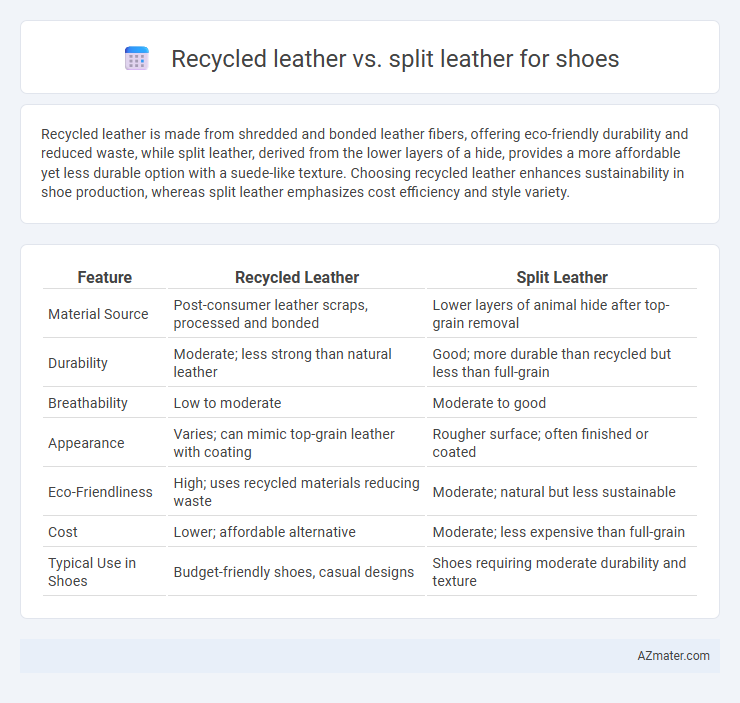Recycled leather is made from shredded and bonded leather fibers, offering eco-friendly durability and reduced waste, while split leather, derived from the lower layers of a hide, provides a more affordable yet less durable option with a suede-like texture. Choosing recycled leather enhances sustainability in shoe production, whereas split leather emphasizes cost efficiency and style variety.
Table of Comparison
| Feature | Recycled Leather | Split Leather |
|---|---|---|
| Material Source | Post-consumer leather scraps, processed and bonded | Lower layers of animal hide after top-grain removal |
| Durability | Moderate; less strong than natural leather | Good; more durable than recycled but less than full-grain |
| Breathability | Low to moderate | Moderate to good |
| Appearance | Varies; can mimic top-grain leather with coating | Rougher surface; often finished or coated |
| Eco-Friendliness | High; uses recycled materials reducing waste | Moderate; natural but less sustainable |
| Cost | Lower; affordable alternative | Moderate; less expensive than full-grain |
| Typical Use in Shoes | Budget-friendly shoes, casual designs | Shoes requiring moderate durability and texture |
Introduction to Recycled Leather and Split Leather for Shoes
Recycled leather for shoes is made from shredded leather scraps bonded with polyurethane or latex, offering an eco-friendly alternative that reduces waste and environmental impact. Split leather, on the other hand, is produced by splitting the hide beneath the top grain layer, resulting in a more affordable material with a looser fiber structure that is less durable than full-grain leather. Both materials serve unique purposes in shoe manufacturing, balancing sustainability and cost-efficiency.
What is Recycled Leather?
Recycled leather for shoes is made by processing leather scraps and fibers bound together with adhesive to create a material that mimics genuine leather while reducing waste. It offers an eco-friendly alternative with enhanced sustainability by utilizing leather offcuts that would otherwise be discarded in tanneries. Split leather, in contrast, is derived from the lower layers of a hide and has less durability and breathability compared to the engineered composition of recycled leather materials.
What is Split Leather?
Split leather is made from the lower layers of a hide after the top grain has been separated, offering a fibrous texture that is less durable than full-grain leather. It is often coated or embossed to mimic the appearance of top-grain leather, making it a popular choice for affordable shoe manufacturing. Compared to recycled leather, split leather provides a more consistent structure but may lack the environmental benefits associated with recycled materials.
Key Differences Between Recycled and Split Leather
Recycled leather is made by combining leather scraps and fibers with binders, resulting in a material that offers eco-friendly benefits but may lack the durability and breathability of natural leather. Split leather is derived from the fibrous lower layers of a hide separated from the top grain, providing greater strength and flexibility but less surface quality compared to full-grain leather. Key differences include recycled leather's lower durability and environmental focus versus split leather's balance of affordability, toughness, and compromised natural appearance.
Durability: Recycled Leather vs Split Leather
Recycled leather, made from leather scraps bonded together, generally offers lower durability compared to split leather, which is derived from the fibrous layers beneath the grain of full-grain leather. Split leather retains more natural strength and resistance to wear and tear, making it more suitable for long-lasting shoe construction. The bonding process in recycled leather can lead to quicker degradation under stress, whereas split leather's fibrous structure provides enhanced durability and resilience.
Aesthetic and Texture Comparison
Recycled leather offers a unique aesthetic with a slightly uneven texture and visible fiber patterns due to its composite material composition, giving shoes a distinctive, eco-friendly appeal. Split leather, derived from the fibrous lower layer of hides, has a finer, smoother texture that can be embossed or coated for a consistent, polished look commonly found in high-quality footwear. The textural difference results in recycled leather shoes feeling more rugged and less uniform, while split leather provides a softer, more refined surface preferred for stylish, durable shoes.
Sustainability and Environmental Impact
Recycled leather for shoes significantly reduces environmental impact by repurposing scrap leather, lowering landfill waste, and minimizing water and chemical usage compared to traditional leather processing. Split leather, derived from the fibrous layer beneath the grain surface of animal hides, often involves heavier chemical treatments and contributes to greater pollution and resource consumption. Choosing recycled leather supports sustainable manufacturing practices and promotes circular economy principles within the footwear industry.
Cost Analysis: Which Leather is More Affordable?
Recycled leather is generally more affordable than split leather due to lower production costs and the use of leftover leather fibers combined with synthetic materials. Split leather, derived from the fibrous portion of the hide separated from the top grain, tends to be more expensive because it requires higher-quality raw hides and more intensive processing. For budget-conscious shoe manufacturers, recycled leather offers a cost-effective alternative without compromising on style or sustainability.
Suitable Applications in Shoe Manufacturing
Recycled leather is ideal for casual or fashion footwear where eco-friendly materials and cost-effectiveness are prioritized, offering a sustainable alternative without compromising style. Split leather, derived from the lower layers of animal hide, provides enhanced durability and breathability, making it suitable for performance shoes and work boots requiring strength and resilience. Manufacturers select recycled leather for soft, flexible uppers, while split leather is preferred for structural components like midsoles and reinforcements.
Choosing the Right Leather for Your Shoes
Recycled leather offers an eco-friendly option by combining leather scraps with synthetic materials, resulting in a durable and cost-effective choice ideal for casual shoes. Split leather, derived from the lower layers of a hide, provides greater flexibility and breathability but may lack the strength and longevity of full-grain leather shoes. When choosing the right leather for your shoes, consider recycled leather for sustainability and affordability, whereas split leather suits styles requiring softness and moderate durability.

Infographic: Recycled leather vs Split leather for Shoe
 azmater.com
azmater.com